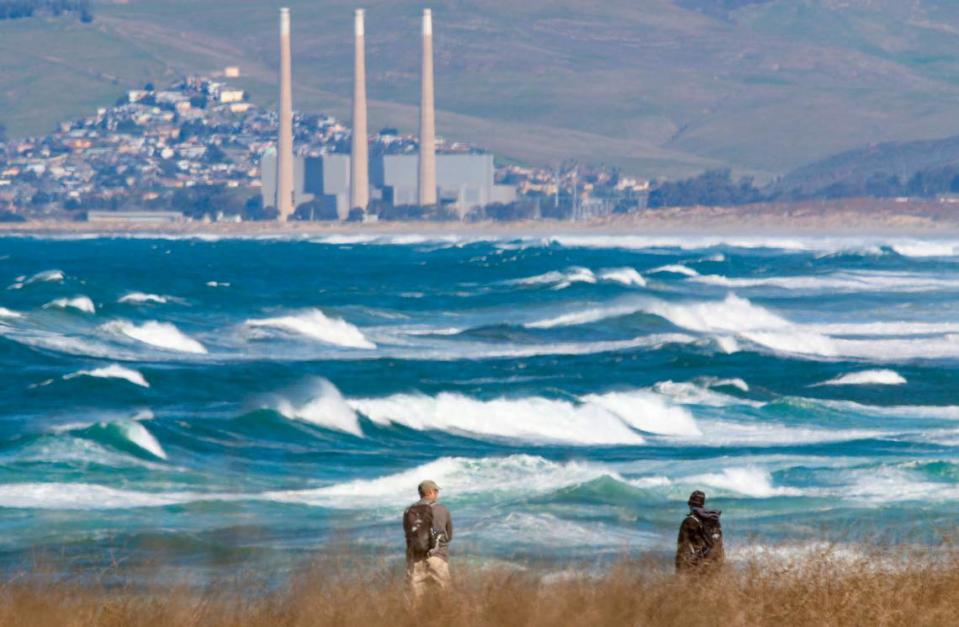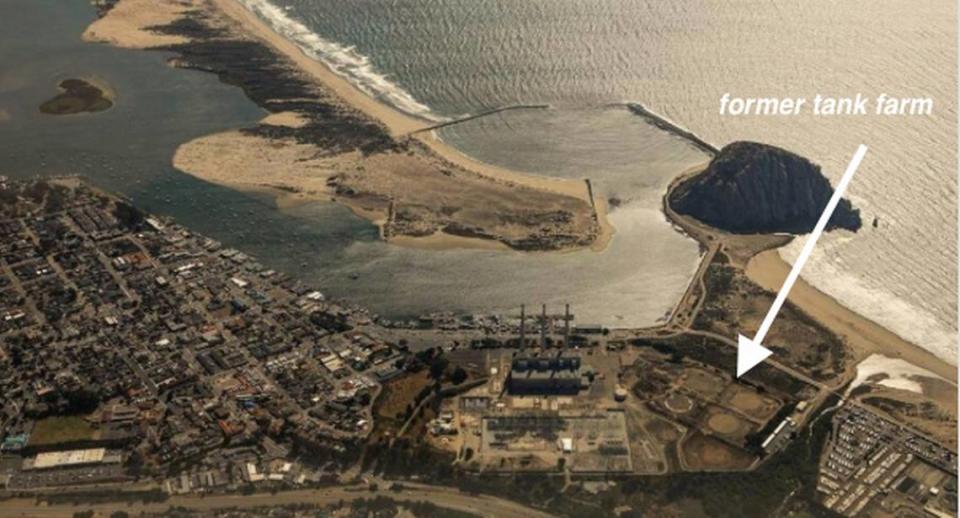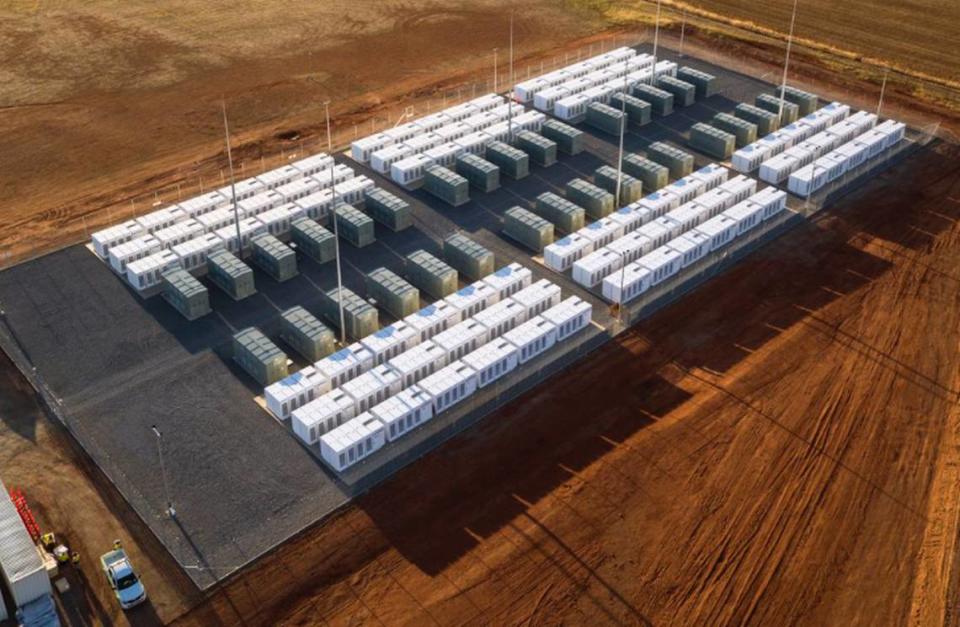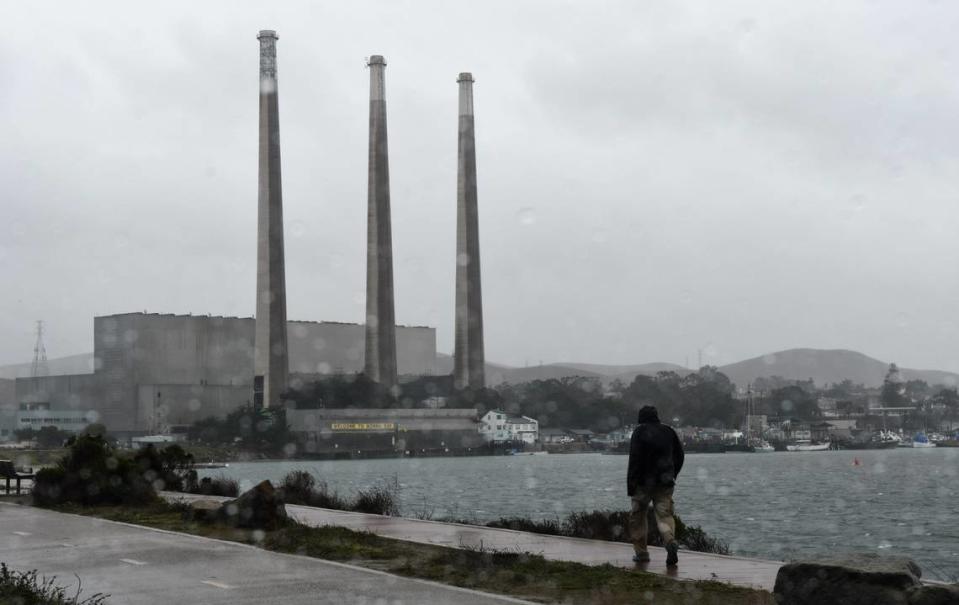Massive battery storage plant planned for Morro Bay. Here’s how voters could stop it
Community members have a new plan to block a Texas-based energy company from building a massive battery storage plant at the site of the shuttered Morro Bay Power Plant.
Vistra Corp. wants to build a 24-acre, 600-megawatt energy storage facility on the property at 1290 Embarcadero.
However, a citizen initiative proposed by Citizens for Estero Bay Preservation could prevent the Morro Bay City Council from approving the battery plant.
“We are known as a cute little fishing village,” group member Betsy Gaudette-Cross said. “One incident could change our whole brand from that to batteries on the bay.”
On Aug. 9, Citizens for Estero Bay Preservation filed a petition with the city supporting the initiative — which garnered an unofficial count of 1,486 signatures, according to Morro Bay City Clerk Dana Swanson.
A valid petition must be signed by 10% of registered voters, which is 815 people in Morro Bay, Swanson said.
Swanson will finish verifying signatures to confirm the official count by Friday.
Once the city certifies the petition, the City Council can then either vote to pass the initiative or place it on the March 2024 ballot.
Opponents of the initiative say Vistra could use a loophole to get the project approved elsewhere.
“Vistra will still get this battery project,” former Morro Bay City Council member Marlys McPherson said.

What would SLO County battery storage plant look like?
Built in the 1950s, the Morro Bay Power Plant was initially operated by PG&E until the energy company sold it to Duke Energy in 1998, according to the city.
Dynegy took ownership of the plant in 2007 before closing it permanently in 2014, causing the city to lose about $800,000 in property tax revenue.
Vistra Corp. merged with Dynegy in 2018, acquiring the former power plant property and its iconic 450-foot-tall emission stacks.
The battery storage project, which Vistra pitched to the community in 2021, would feature three Costco warehouse-sized buildings housing 180,000 batteries — which could hold enough electricity to power 450,000 homes, according to Vistra’s website.
The plant would most likely store lithium ion batteries, but the type of battery could change as technology evolves, according to Morro Bay Community Development Director Scot Graham.
City staff are reviewing a draft environmental impact report for the project, which will be released to the public in January or February, Graham said.
Eventually, the Morro Bay Planning Commission will review the project before sending it to the City Council for final approval.
The project also requires a coastal development permit, which must be approved by the California Coastal Commission.
Vistra agreed to tear down the power plant and its three emission stacks by 2027 or pay the city $3 million, Graham said.
Eventually, the stacks will deteriorate and become a safety hazard, and they’re also “a visual blight,” he said.
“The idea here is that if you got rid of that stuff, it opens it up for other uses,” Graham said.
The battery plant would generate between $300,000 and $400,000 annually in property taxes for Morro Bay, according to Graham.
If Vistra abandons the project, the company would have to sell the property to someone who could afford to remove the stacks, which could cost up to $50 million, Graham said.
“You need some other economic engine to pay for the demo of the stacks and the building,” Graham said.

What would Morro Bay citizen initiative do?
If passed by the City Council or voters, the citizen initiative would freeze the land use designation of the Morro Bay Power Plant property as commercial-recreational fishing and visitor-serving commercial, which allows developments including hotels, shops and restaurants, according to Citizens For Estero Bay member Barry Branin.
This would prevent the City Council from approving the battery plant, Branin said, as the project would then not align with the property’s designated land use.
Right now, a majority vote from the City Council can change a property’s land use designation.
If the initiative passes, citizens would have to propose a ballot measure to be approved by a majority of city voters to change the property’s land use, Branin said.
The citizen group doesn’t think the battery plant is safe enough to build next to Morro Bay High School, the Embarcadero and sensitive habitat in the bay, according to Branin.
In 2021, batteries overheated at Moss Landing, a Vistra-owned battery plant in Monterey County. The incident did not cause a fire, but prompted Vistra to temporarily close the facility.
Branin pointed to a 2022 fire at Tesla’s Elkhorn Energy Battery Storage Facility, also located at Moss Landing but not owned by Vistra.
The North County Fire Protection District closed Highway 1 while firefighters fought the fire, the incident report said.
Neither incident resulted in injuries.
According to Branin, such incidents show that battery storage facilities are not safe to locate in highly populated areas.
The citizen group prefers that battery plants are built in less populated areas, such as Kettleman City or Buttonwillow, while the technology is improved.
“We know that batteries are going to evolve,” Branin said. “But we don’t want to be the place to experiment.”
Branin suggested building an amphitheater on the Morro Bay Power Plant property instead.
“It’ll increase all of the tourist dollars that come into this town,” Branin said. “You’ll fill motels all year round.”

Would freezing land use designation block power plant?
Opponents of the citizen initiative said that freezing the land use designation would not actually stop Vistra from building the power plant.
Assembly Bill 205 allows developers to submit large renewable energy projects to the California Energy Commission for approval — bypassing local jurisdictions such as the Morro Bay City Council, according to McPherson.
The California Coastal Commission would also have to approve the project, McPherson said, but she expects the agency to favor the battery plant.
“Four of (the commissioners) were appointed by the governor, who wants these kind of projects,” McPherson said. “That’s why he passed the law, to bypass people who say, ‘Not in my backyard.’ ”
According to McPherson, the initiative would transfer project approval to state agencies, and Morro Bay residents would lose a chance to give input on the battery plant’s design.
Though Morro Bay residents have avenues to give input to the City Council, the Coastal Commission and the state Energy Commission are not as accessible to the public, McPherson said.
Morro Bay residents can tell the city council what they want to project to look like, McPherson said. If the citizens don’t like the outcome, they can vote for different city council members, she said.
“There’s established processes for getting citizen input,” McPherson said. “You can go to the advisory boards, come to council meetings, speak at public comment.”
If the city council has the authority to approve the project, they can require Vistra to modify the battery plant to better suit the community, McPherson said.
“Our city council could negotiate with Vistra to maybe get some concessions,” McPherson said. “They’ve already said they would take down the plant and the stacks, maybe they would delay building for another five years so we can have better batteries.”
Branin, however, said he’s confident that the Coastal Commission wouldn’t approve a project that violates the city’s land use designation — so he doesn’t agree that the battery plant is inevitable, he said.

Can hotels, shops be built on property?
When PG&E sold the Morro Bay Power Plant property to Duke Energy in 1998, the sale agreement prohibited all future owners from using the property for hotels, playgrounds or any other development that potentially exposes people to contamination on site.
The sale agreement says that the property owner would be responsible for any injuries caused by pollution on site.
This way, no one can sue PG&E to clean up the property, McPherson said.
McPherson said she thinks it’s unlikely that a developer would want to spend millions of dollars to buy the property, remove the power plant and stacks, then clean up the pollution to build a visitor-serving project like a hotel or aquarium.
In San Francisco, however, a developer and property owner successfully removed PG&E’s deed restriction on the Protrero Power Plant to allow for a mixed-use development that includes housing, commercial buildings and open space, according to Graham.
“They’re in an area that was completely industrial before and now it’s being kind of revitalized,” Graham said. “All we took away from that is, oh, you can get the deed restriction lifted.”
Branin said he thinks Vistra could find a developer interested in cleaning up the property for tourism.
“The question is, ‘What’s the property worth if it were clean?” Branin said. “It’s a beautiful, bay-front location on the Embarcadero that could be worth millions of dollars.”
